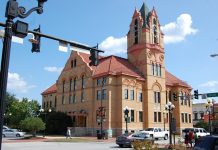By Stan Welch
The Planning and Public Works committee of the Anderson County Council met Monday, to begin reviewing the county’s contract with the owner and operator of the Anderson Regional Landfill (ARL), an effort that was thwarted by the absence of the contract documents, which county staff has been unable to locate.
Committee chairperson Cindy Wilson has speculated that the original documents were removed from the courthouse following the departure of former county administrator Joey Preston, who supervised the sale of the Big Creek landfill to NationsWaste for less than $2 million.
Wilson has persistently questioned that negotiation and transaction, leading to her being the target of at least one lawsuit by Preston personally.
She did have one document in hand, related to the closing of the deal. She pointed out several discrepancies in the manner that the document was prepared and executed, based on her experience in the real estate industry, but she conceded that, until further documents are located and retrieved, it is difficult to proceed.
The committee then moved on to a review of the solid waste plan, where they acknowledged that the remaining life span of the ARL is reduced to the point that it is becoming an issue of some urgency.
According to figures provided in the county’s most recent report to DHEC on the status of the landfill, the permitted capacity could be reached in as little as thirteen and a half years, based on the maximum rate of disposal allowed, which is 438,000 tons of solid waste annually.
According to solid waste department director Greg Smith, the county disposed of 347,000 tons last year. At that rate, the landfill could operate for another twenty three years.
The landfill’s acceptance of solid waste from other counties in the area affects that disposal rate, a fact that committee member Craig Wooten raised. “If we stopped accepting garbage from those other counties, how long would that extend the life of the landfill?”
Wilson appeared more concerned about the possibility that solid waste from other states was being brought in to the transfer station in Duncan, SC and being surreptitiously substituted for authorized shipments, a condition that would violate the landfill contract.
Wilson reported that Teresa Locke Morgan and other citizens had surveilled the transfer station, and observed such actions. She expressed her hope that solid evidence of such conduct might be useful in gaining leverage in the upcoming negotiations of the contract which expires at the end of this year. Her two committee members saw such leverage as being of limited value, since the current ARL owner and operator, Waste Connection, still owns the only game in the county.
The issue of mandatory recycling was discussed, with Smith reporting that Anderson County currently leads the state with a voluntary recycling rate of forty two per cent, or two per cent above state goals for recycling. Curbside recycling is of limited value in Anderson County due to its largely rural nature, and its relatively sparse population.
Councilman Ken Waters raised the issue of disposal and/or recycling of electronic waste, such as computer monitors and televisions and other small appliances. Two issues result from that situation. One is that such waste is inordinately heavy, and impacts the permitted tonnage. Secondly, much of the electronics contain hazardous materials and heavy metals, posing risks to both the environment and to those attempting to reclaim the valuable materials from the waste.
Waters questioned whether it would be worthwhile for the county to undertake the recycling of the electronics, but Smith pointed out both the physical dangers, as well as the fact that private companies attempting such enterprise are suffering economically.
There are other classes of landfills in the county that are also facing shortening life spans. Class one landfills can only receive land clearing debris, such as leaves and limbs, while Class two facilities can accept construction and debris from development and construction. The rate of the growth in the county, especially the northern part, is increasing the stress on such facilities. At the same time, increasing property values and land prices in the areas of high growth, as well as the increasingly dense populations, make it problematic to locate new landfills in the areas that need them most.
But the Class Three, subtitle D lined landfill for mainstream solid waste (MSW) is by far the most expensive, intricate and difficult to permit of all the landfills.
There is also a seventy five mile radius provision in the DHEC permitting protocol that prevents locating two MSW facilities within that distance of each other. That prohibition was actually put in place as a result of the establishment of the ARL. At that time, in 1998, the main effect of the prohibition was to ensure that the TriCounty Regional Landfill project, which was dismantled just prior to the sale of Big Creek landfill, could not be revived.
The committee then heard from Megan Young, of the roads and bridges department, who imparted some grim news about the possibility of subdivisions, developments, or other residential areas generating enough revenue from property taxes to maintain their own roads. The short answer is that it is impossible. Two examples were provided.
The first was the Shadow Oaks subdivision, which contains seventy two lots in a fairly dense configuration. While the Shadow Oaks subdivision generated almost $1.6 million in property tax revenues between 1993 and 2015, only thirty five thousand dollars of that was allocated for roads and bridges.
The current estimated cost of repaving the roads in the subdivision is $235,00, leaving a shortfall of $200,000. To generate tax revenues at a rate sufficient to raise that amount every twenty years, each lot would have to be taxed at $163 annually. That does not take into account any increase in the paving costs over the twenty year stretch.
The second example provided, Royster Road, which contains only four parcels, is even more ludicrous. Over the twenty year span between 1995 and 2015, the Royster Road properties generated one hundred and seventeen dollars for allocation to roads and bridges. The cost estimate for repaving Royster Road is $194,000. To generate that amount every twenty years, the four lots would have to be taxed at $2,425 a year. Assistant county administrator Holt Hopkins stated simply that there is no way that property taxes can be counted on to finance road maintenance.
















